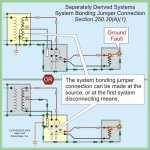- Location
- Lockport, IL
- Occupation
- Semi-Retired Electrical Engineer
I had thought this was simple and basic. Then I was put into a position where I had to go back and read the book again. Imagine that, having to deal with Charlie's Rule! 
Situation: At the secondary of a 480 ? 120/208V transformer, I run one wire from XO to a ground bar in the electrical room, and there is another wire going from there to (eventually) planet earth. Let?s ignore them.
From the secondary, I run 5 wires to an MCB panel in the same room, and the N-G bond takes place inside that panel. Four of the wires are Phases A, B, C, and the neutral. What is the 5th wire? Is it an Equipment Grounding Conductor, to be sized per 250.122? Or is it an Equipment Bonding Jumper, to be sized per 250.66?
I designed it as an EGC. The Inspector says it should have been sized as an EBJ.
Situation: At the secondary of a 480 ? 120/208V transformer, I run one wire from XO to a ground bar in the electrical room, and there is another wire going from there to (eventually) planet earth. Let?s ignore them.
From the secondary, I run 5 wires to an MCB panel in the same room, and the N-G bond takes place inside that panel. Four of the wires are Phases A, B, C, and the neutral. What is the 5th wire? Is it an Equipment Grounding Conductor, to be sized per 250.122? Or is it an Equipment Bonding Jumper, to be sized per 250.66?
I designed it as an EGC. The Inspector says it should have been sized as an EBJ.



